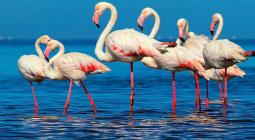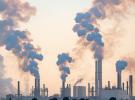Five Patagonian Lakes Are Rapidly Drying, Study Shows
In western Argentina, five lakes within a national park continue to shrink. Scientific findings are now paving the way for restoration efforts—but ongoing federal funding cuts now pose another threat.
Hidden between volcanic cones in the Patagonian Steppe lies Laguna Blanca, an oasis-like lake in an otherwise arid region. Home to black-neck swans, red-eyed silvery grebes and dark-spotted endemic frogs, the serene body of water is the main attraction of the Laguna Blanca National Park, a natural reserve in the Argentine Province of Neuquén.
Over the last two decades, the lake’s area has declined dramatically. A meter used to measure lake levels is now fully exposed, as are dry rocks that were once fully underwater. “Looking at the rulers used for measurements 20 years ago, you wouldn’t believe the lake used to reach those levels,” Facundo Scordo said in Spanish.
Scordo, an Argentine geographer based at the University of Nevada, Reno, is the lead author of a study published in February in the journal Science of the Total Environment. According to its findings, Laguna Blanca and four other smaller lakes within the national park have decreased in surface area by up to 52 percent since 2007.
These drastic changes are particularly concerning due to the park’s status as a Ramsar site—a UNESCO-recognized wetland of international importance. “It once had a community of birds so wonderful that it was the first Ramsar site in Argentina,” said Esteban Balseiro, a professor at the National University of Comahue specializing in the field of limnology, the study of inland aquatic ecosystems. But now “the current population of aquatic birds is absolutely minimal,” said Balseiro, who was not involved in the study.
To track changes in lake surface over time, Scordo and his colleagues analyzed satellite images of the five lakes and a drought index for every year between 1998 and 2024. “We then analyzed whether the observed lake recession is only the product of climate variability or also anthropogenic factors,” Scordo explained.
Their results show that changes in climate, namely increased dryness, have reduced the surface area of Laguna Blanca and surrounding lakes to a greater extent. Still, their findings suggest that human intervention on the natural landscape has played a role, too.
Between 2020 and 2025, local farmers constructed over 50 irrigation channels on the upper basin of the Llano Blanco Stream, Laguna Blanca’s main water source. These channels were built perpendicular to the direction of the stream’s natural flow, diverting water to support agricultural activities while reducing the lake’s volume.
Farmers evidently did not construct these channels to dry up the lake, Scordo clarified, but “simply because of productive convenience and because they did not understand the impacts their activities could be having downstream in the lower basin.”
The resulting decrease in volume has led to a higher concentration of nutrients in the lake’s water. As a consequence, harmful algal blooms have become more frequent, negatively affecting tourism, and with it the local economy. Today, the park’s website features a red warning sign. “The fishing season in Laguna Blanca is suspended until further notice due to an extraordinary algal bloom in the body of water,” it reads.
Such negative implications highlight the necessity of federally funded scientific research in the face of climate change. “For me, data is of utmost importance,” said Scordo, whose research project was funded by CONICET, the National Scientific and Technical Research Council of Argentina.
As his study shows, research findings can pave the way for collaborations between different stakeholders. “When authorities in Neuquén showed the farmers that what they were doing was significantly affecting a lake inside a national park, the farmers agreed to reverse what they had done,” he said.
In light of this, Scordo warns about ongoing threats posed by the Argentine government’s climate change denialism and cuts to science funding. “With the current administration, there is a political misbelief that climate change is not real, and that generates no framework in which policies for the conservation of water resources can be made,” he said.
Carina Seitz, a fellow researcher at the University of Comahue and co-author of the study, echoed a similar view, describing the implications of dismantling organizations devoted to advancing science and technology. “It jeopardizes the conservation of our National Parks, as well as the invaluable richness of our flora, fauna, and landscape diversity,” Seitz said in Spanish in an interview for SciDev.Net.
Amid such threats to research funding, Scordo emphasizes how science can foster collaboration across different societal sectors. As a product of the study’s findings, Scordo said, “the authorities of Neuquén are now working with farmers to restore the stream to its former conditions.”
“Science does end up contributing to politics,” he said.
Cover photo: Leonardo Buria, the National Parks Northern Patagonia Regional Director of Conservation, holds up a ruler that in 2007 was completely covered by water in Laguna Blanca National Park. Credit: Facundo Scordo




